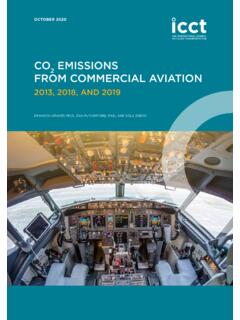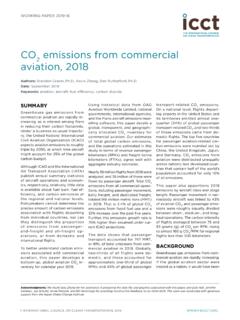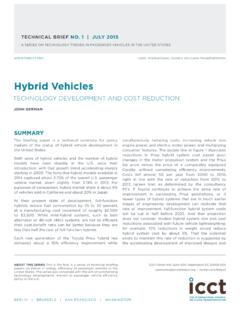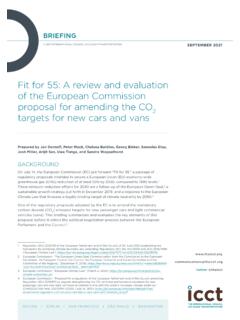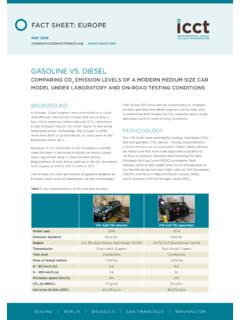Transcription of Estimating sustainable aviation fuel feedstock ...
1 WORKING PAPER 2021-13. 2021 INTERNATIONAL COUNCIL ON CLEAN TRANSPORTATION. MARCH 2021. Estimating sustainable aviation fuel feedstock availability to meet growing European Union demand Authors: Jane O'Malley, Nikita Pavlenko, Stephanie Searle Keywords: Biofuels, low-carbon fuels, aviation Summary If the European Union aviation industry is to meet its long-term goal of decarbonization without curbing traffic growth or relying on out-of-sector carbon offsets, switching to sustainable aviation fuels (SAFs) is one of the few methods of achieving in-sector greenhouse gas (GHG) reductions.
2 Though previous, transport-wide EU fuel policies have done little to stimulate the development of the SAF industry, the recently proposed ReFuel EU initiative could set a clear policy signal for the introduction and expansion of an advanced-only SAF industry producing ultra-low carbon fuels. However, it is critical that policymakers set realistic SAF deployment goals that match the amount of fuel that could be made from available feedstock . This study evaluates the EU resource base to support SAF production from 2025 to 2035, focusing only on the potential volumes available from sustainably available feedstocks .
3 Without taking into account the political or economic barriers to SAF production, we estimate that there is a sufficient resource base to support approximately million tonnes (Mt) of advanced SAF production annually, or of projected EU jet fuel demand in 2030. The estimated production potential takes into account feedstock availability, sustainable harvesting limits, existing other uses of those materials, and SAF. conversion yields. This assessment does not factor in the economic incentives necessary to drive that level of market demand or to mobilize investment in new The commercialization of SAF depends on many factors beyond the resource base for SAF production.
4 Currently, even with some incentives and targeted support in place, SAF production covers less than of global jet fuel demand. While producing SAF. from waste oils is the most technically mature SAF conversion pathway, waste oils are highly resource-constrained and are already largely consumed by the road sector. High near-term targets for SAF blending may only incentivize the diversion of waste oils from existing uses in the road sector, approaching approximately 2% of 2030 jet fuel demand from waste oil alone. Moving beyond 2% of SAF deployment will require targeted twitter @theicct support for more conversion pathways with more challenging economics and uncertain production timelines.
5 To achieve long-term success for the advanced SAF industry, the Acknowledgements: Thanks to Dan Rutherford of the ICCT, Karlijn Arts of SkyNRG, and Laura Buffet of Transport & Environment for helpful reviews. ReFuel EU initiative must first lay the groundwork for these pathways through targeted incentives for individual projects before laying out a sector-wide blending target. Introduction As part of the Green Deal framework, the ReFuel EU initiative announced in 2020 is intended to reduce the environmental footprint of the EU aviation sector by building supply and demand for sustainable aviation fuels (SAFs) (European Commission, ).
6 Significant technological barriers to electrification make fuel -switching one of the only methods of reducing aviation GHG emissions without curbing demand. While first-generation biofuels made from food crops account for about 5% of EU road sector fuel consumption and more than 15 billion liters of annual production, the sustainability of these fuels has also been called into question because of high indirect land use change (ILUC) emissions (Valin et al., 2015) and displacement effects across use in other industries (Searle, Pavlenko, Takriti, & Bitnere, 2017).
7 While SAFs made up only of global jet fuel consumption in 2019 (European Commission, ), it is possible that their use could expand over the next decade through expanded policy support. Deploying SAFs requires overcoming even greater economic and technological constraints than deploying alternative fuels to the road sector. SAF pathways require additional testing and certification to demonstrate their safety before commercial use, adding to the expense and difficulty of their commercialization relative to road fuels. Petroleum jet fuel has lower GHG emissions and a lower price than petroleum diesel, making the uptake of alternative fuels costlier on a per-tonne carbon dioxide equivalent basis in aviation than in the road sector.
8 In addition, modifying biorefineries with a mixed product slate to produce a greater share of SAF in place of diesel would be less efficient (Pavlenko, Searle, & Christiansen, 2019). While petroleum refiners have had mandates to blend biofuels in the road sector in the United States and the European Union for more than a decade, there has not been a corresponding policy to spur aviation fuel demand. The Carbon Offsetting and Reduction Scheme for International aviation (CORSIA), the international aviation industry's contribution to the Paris Agreement, is primarily viewed as a carbon offsetting plan rather than one that will promote SAFs (IATA, 2019).
9 As of 2019, the vast majority of biofuel production in the European Union comes from first-generation, food-based biofuel (Phillips, Flach, Lieberz, & Bolla, 2019). This includes rapeseed, soy, and palm oils as well as wheat, maize, and sugar beet, which are relatively easy to convert using first-generation biofuel production processes. However, the European Union is increasingly supportive of transitioning away from food-based biofuels. Policymakers introduced a cap on the contribution of these fuels to the transport-sector target within the recast Renewable Energy Directive (RED II) and have suggested that policy support within ReFuel EU focus on promoting advanced fuels.
10 These include biofuels produced from feedstocks largely defined in Annex IX of the RED. II: primarily lignocellulosic byproducts, wastes, and residues. Other sustainable advanced fuels could be made from renewable electricity or wastes from fossil fuel -based processes if they generate significant GHG savings relative to conventional petroleum- derived fuels. By targeting the deployment of advanced SAFs from nonfood feedstocks early on, the nascent SAF industry may be in a position to avoid the political controversies around the social and climate consequences of food-based biofuels.
